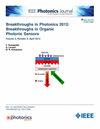All-Optical Inhibitory Dynamics by Backscattering With Unidirectional Injection-Locked Photonic Spiking Neuron
IF 2.4
4区 工程技术
Q3 ENGINEERING, ELECTRICAL & ELECTRONIC
引用次数: 0
Abstract
Inhibitory dynamics plays an important role in the information processing of biological spiking neurons, where incoming stimuli weaken the activity level of neurons. Due to the lack of prohibitive physical effects in photonics, the realization of the photonic spiking neuron (PSN) with intrinsic inhibitory dynamics and the application of efficient inhibitory dynamics in the optical domain have been challenging. Herein, we propose a PSN with all-optical inhibitory dynamics, which is achieved by intrinsic backscattering from the unidirectional-emitted semi-conductor ring laser (SRL) to the master laser. The photonic spiking dynamics of the SRL operating in unidirectional mode were investigated, demonstrating the computational properties of the PSN as a leaky integrate-and-fire neuron. We prove that as the backscattering intensity increases, the number of spikes generated under the same input signal decreases. Under the influence of backscattering, the number of spikes fired increases with the input signal rate. In the speech signal classification task, the classification accuracy improves from 89% to 94% under the influence of inhibitory dynamics. This suggests that the presence of inhibitory dynamics helps filter out unwanted interference information. The results show the potential of backscattering-based inhibition dynamics for facilitating advanced neuromorphic information processing.单向注入锁定光子脉冲神经元后向散射的全光抑制动力学
抑制动力学在生物尖峰神经元的信息处理中起着重要作用,其中传入的刺激削弱了神经元的活动水平。由于光子学中缺乏禁止物理效应,具有内在抑制动力学的光子尖峰神经元(PSN)的实现以及有效抑制动力学在光学领域的应用一直是一个挑战。在这里,我们提出了一个具有全光抑制动力学的PSN,它是通过从单向发射的半导体环形激光器(SRL)到主激光器的本征后向散射来实现的。研究了SRL在单向模式下的光子尖峰动力学,证明了PSN作为漏积分-放电神经元的计算特性。我们证明了在相同的输入信号下,随着后向散射强度的增加,产生的尖峰数减少。在后向散射的影响下,发射的尖峰数随着输入信号速率的增加而增加。在语音信号分类任务中,在抑制动态的影响下,分类准确率从89%提高到94%。这表明抑制动力学的存在有助于过滤掉不需要的干扰信息。结果表明,基于后向散射的抑制动力学在促进高级神经形态信息处理方面具有潜力。
本文章由计算机程序翻译,如有差异,请以英文原文为准。
求助全文
约1分钟内获得全文
求助全文
来源期刊

IEEE Photonics Journal
ENGINEERING, ELECTRICAL & ELECTRONIC-OPTICS
CiteScore
4.50
自引率
8.30%
发文量
489
审稿时长
1.4 months
期刊介绍:
Breakthroughs in the generation of light and in its control and utilization have given rise to the field of Photonics, a rapidly expanding area of science and technology with major technological and economic impact. Photonics integrates quantum electronics and optics to accelerate progress in the generation of novel photon sources and in their utilization in emerging applications at the micro and nano scales spanning from the far-infrared/THz to the x-ray region of the electromagnetic spectrum. IEEE Photonics Journal is an online-only journal dedicated to the rapid disclosure of top-quality peer-reviewed research at the forefront of all areas of photonics. Contributions addressing issues ranging from fundamental understanding to emerging technologies and applications are within the scope of the Journal. The Journal includes topics in: Photon sources from far infrared to X-rays, Photonics materials and engineered photonic structures, Integrated optics and optoelectronic, Ultrafast, attosecond, high field and short wavelength photonics, Biophotonics, including DNA photonics, Nanophotonics, Magnetophotonics, Fundamentals of light propagation and interaction; nonlinear effects, Optical data storage, Fiber optics and optical communications devices, systems, and technologies, Micro Opto Electro Mechanical Systems (MOEMS), Microwave photonics, Optical Sensors.
 求助内容:
求助内容: 应助结果提醒方式:
应助结果提醒方式:


